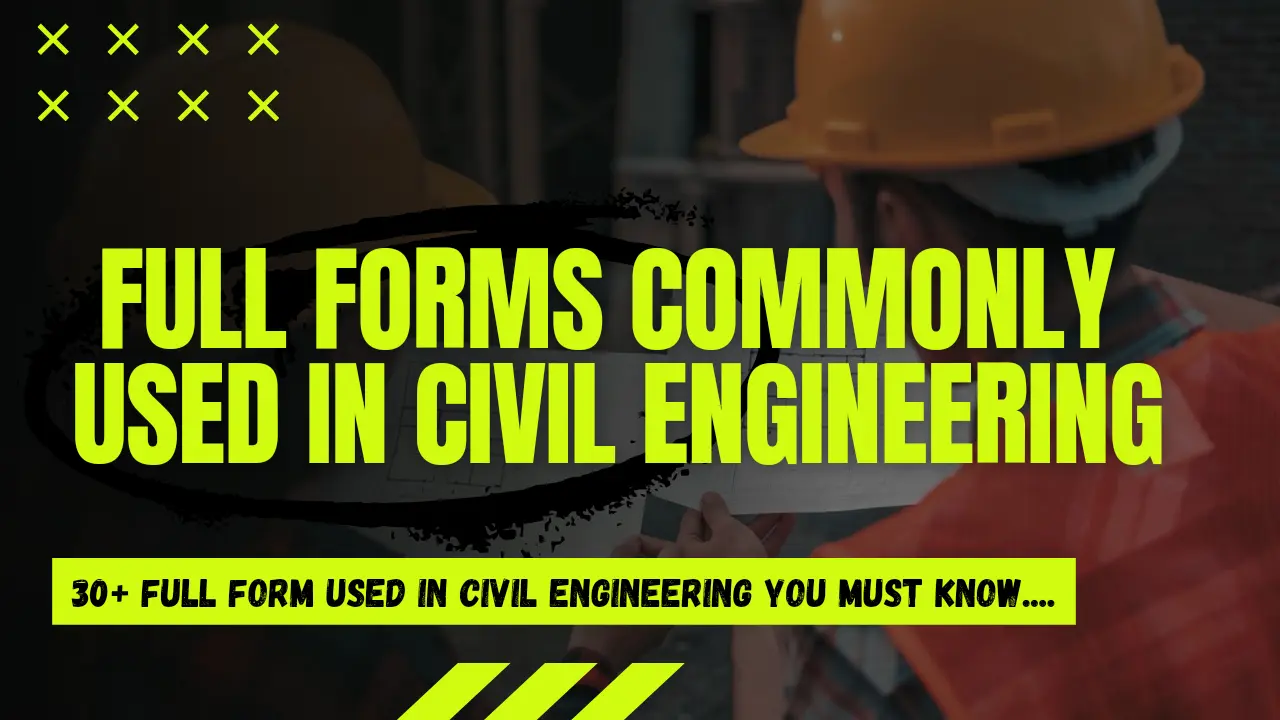Table of Contents
Civil engineering is filled with various abbreviations and acronyms that are essential for professionals in the field. In this post, we will explore the most commonly used full forms in civil engineering, giving you a better understanding of these critical terms.
If you are a civil engineer, then you must know some abbreviations. Often, different abbreviations are used on-site or in your educational office, such as RCC, BIM, PCC, IS, and BBS. If someone suddenly asks you what RCC stands for, you should be able to provide an explanation so that you understand its full form and never feel unsure in your professional life. After completing your engineering degree, you might find yourself unfamiliar with these abbreviations, so I hope you read and understand this post in detail and pay attention to how you can apply this knowledge in your professional life. There are many more abbreviations that will be useful for you in the future. If I receive a good response to this post, I will definitely make another post covering more abbreviations.
RCC – Reinforced Cement Concrete
Reinforced Cement Concrete (RCC) is a material where cement concrete is reinforced with steel bars to improve tensile strength. It is commonly used in building structures, bridges, and other civil engineering applications.
PCC – Plain Cement Concrete
Plain Cement Concrete (PCC) is a basic mixture of cement, sand, and aggregate, without any reinforcement. It’s used as a foundation bed and to level surfaces for construction projects.
IS – Indian Standard
Indian Standard (IS) codes provide specifications and guidelines for materials, methods, and practices in civil engineering projects. IS 456 and IS 800 are popular codes used in concrete and steel construction.
BBS – Bar Bending Schedule
The Bar Bending Schedule (BBS) details the quantity, size, and shape of steel bars used in RCC. It’s essential for proper reinforcement planning and to ensure the project adheres to structural designs.
DPC – Damp Proof Course
The Damp Proof Course (DPC) prevents moisture from rising through a building’s foundation. This technique is crucial in ensuring the longevity and stability of a structure.
MIVAN – Mivan Formwork
Mivan Formwork is an advanced construction technology that involves using pre-engineered aluminum formwork for faster and more efficient construction, particularly in high-rise buildings.
EPC – Engineering, Procurement, and Construction
EPC refers to the process where a single contractor handles engineering, procurement, and construction. This approach is commonly used in large-scale civil engineering projects for timely and cost-effective project completion.
FSI/FAR – Floor Space Index / Floor Area Ratio
Floor Space Index (FSI) or Floor Area Ratio (FAR) is the ratio of a building’s total floor area to the size of the plot on which it’s built. It is commonly used in urban planning and real estate development.
NDT – Non-Destructive Testing
Non-Destructive Testing (NDT) allows engineers to test the integrity of a material or structure without causing damage. It is commonly used in inspecting concrete and steel structures.
CAD – Computer-Aided Design
Computer-Aided Design (CAD) software is used by civil engineers and architects to create detailed 2D and 3D designs for construction projects. It plays a vital role in the planning stages of any project.
BIM – Building Information Modeling
Building Information Modeling (BIM) is a 3D model-based process that enables engineers to plan, design, and manage infrastructure projects more effectively. BIM is becoming a standard tool in modern civil engineering.
CPM – Critical Path Method
The Critical Path Method (CPM) is a project management technique that identifies the longest sequence of activities required to complete a project. It is commonly used in civil engineering for project scheduling.
WBM – Water Bound Macadam
Water Bound Macadam (WBM) is a method of road construction that uses crushed stone aggregates bound with water. It is commonly used for base layers in road projects.
QA/QC – Quality Assurance / Quality Control
Quality Assurance (QA) and Quality Control (QC) are critical processes in civil engineering to ensure that projects meet required standards and specifications. QA/QC is essential in maintaining project integrity.
GFC – Good for Construction
Good for Construction (GFC) drawings are the final approved designs used for construction on-site. These drawings contain all necessary details for executing the work accurately.
TMT – Thermo-Mechanically Treated
Thermo-Mechanically Treated (TMT) bars are steel bars that undergo a special process to enhance their strength and ductility. They are commonly used in RCC structures due to their excellent mechanical properties.
GPS – Global Positioning System
The Global Positioning System (GPS) is widely used in surveying, mapping, and site layout in civil engineering. It helps engineers in achieving precise geographical measurements during the planning phase.
GFRG – Glass Fiber Reinforced Gypsum
Glass Fiber Reinforced Gypsum (GFRG) is a lightweight building material used for constructing walls and partitions. It is commonly used in sustainable construction projects due to its environmental benefits.
PVC – Polyvinyl Chloride
Polyvinyl Chloride (PVC) is a versatile plastic material commonly used in pipes and conduits in civil engineering projects. It is known for its durability, affordability, and corrosion resistance.
BOQ – Bill of Quantities
The Bill of Quantities (BOQ) is a document that outlines the quantities and cost of materials, labor, and services required for a construction project. It is an essential tool in project cost estimation.
TDR – Transfer of Development Rights
Transfer of Development Rights (TDR) is a real estate concept that allows landowners to sell the development rights of their property to developers in different locations. It is commonly used in urban areas.
O&M – Operation and Maintenance
Operation and Maintenance (O&M) refers to the routine upkeep and management of infrastructure, ensuring it functions as intended. It is an essential part of managing civil engineering projects.
PMV – Plant, Machinery, and Vehicles
Plant, Machinery, and Vehicles (PMV) are vital resources in civil engineering projects. Proper management of PMV ensures the efficient execution of construction activities.
RERA – Real Estate Regulatory Authority
The Real Estate Regulatory Authority (RERA) regulates the real estate market, ensuring transparency and fairness in property transactions. RERA compliance is commonly required in civil engineering projects involving real estate.
CPWD – Central Public Works Department
The Central Public Works Department (CPWD) is a government agency responsible for public sector construction projects across India. CPWD manages the development and maintenance of infrastructure, including roads and buildings.
These full forms are commonly used in civil engineering and are essential for professionals in the field. Understanding these abbreviations will help you communicate effectively and manage projects more efficiently. If you want to learn more about civil engineering topics, explore other articles on our website.
Full Forms Commonly Used in Civil Engineering ( Bonus short form )
Infographic: Full Forms in Civil Engineering
FBC – Fibre Reinforced Concrete
Concrete reinforced with fibers to enhance its structural properties.
PP – Pre-stressed Concrete
Concrete that is deliberately stressed to improve performance under load.
AC – Asbestos Cement
Building material composed of cement and asbestos fibers, known for durability.
PS – Precast Structural Elements
Structural components that are manufactured and cured before being transported to the construction site.
ISBL – Inside Battery Limit
Refers to the area within the designated boundaries of a plant or facility.
FRP – Fiber Reinforced Polymer
Composite material made from a polymer matrix reinforced with fibers, used for strengthening structures.
BT – Bituminous Treatment
Application of bituminous materials to improve the durability of road surfaces.
GGBS – Ground Granulated Blast Furnace Slag
Byproduct of steel production used as a supplementary cementitious material in concrete.
PL – Project Lead
The individual responsible for overseeing and managing a construction project.
OHSAS – Occupational Health and Safety Assessment Series
Standards for ensuring workplace health and safety practices.
CP – Cathodic Protection
Method to prevent corrosion of metal surfaces by making them the cathode of an electrochemical cell.

Hi! I’m Sandip, a civil engineer who loves sharing about Civil Engineering & new ideas and tips. My blog helps you learn about engineering in a fun and easy way!

